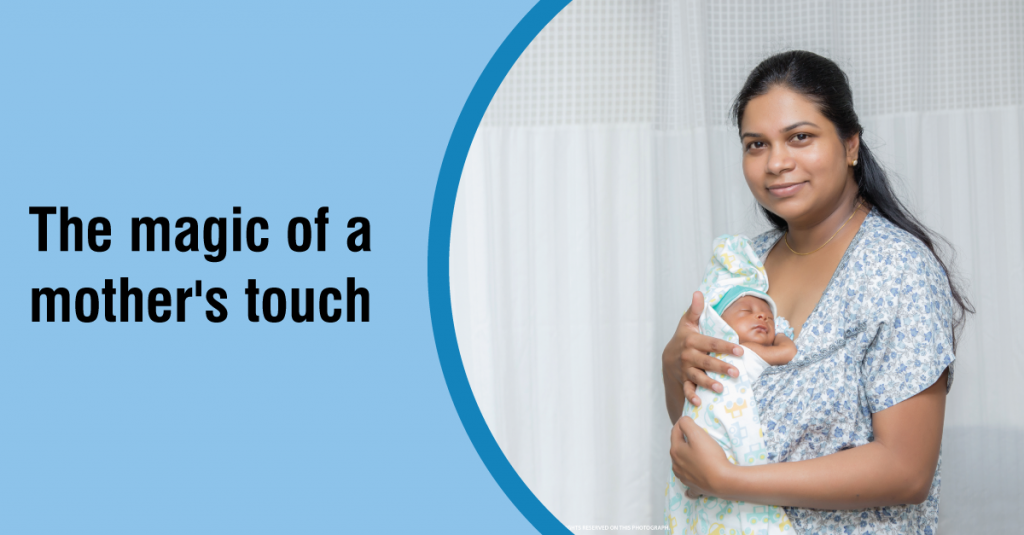
Kangaroo Mother Care (KMC) or skin-to-skin contact are some common phrases you might come across during your childbirth. While it’s easy to guess what it means, why does it matter so much for your baby?
Kangaroo Mother Care (KMC) was first introduced in the 1970s, to promote bonding, early breastfeeding and warm care in low birth weight babies. The World Health Organization (WHO) recommends Kangaroo Mother Care (KMC) for the routine care of newborns weighing 2000 grams or less at their birth.
As weight gain plays an important role in your premature baby, thermal protection of your baby is also a measure to be taken. Your newborn baby is prone to lose more heat easily especially when s/he is premature.
Kangaroo Mother Care (KMC) is a straightforward and easy practice to care for your newborn baby, especially if it’s a premature baby. It involves an early, continuous and prolonged skin-to-skin contact between you and your premature baby. KMC is a very powerful, easy to use method to promote the health and well-being of your baby.
Types of Kangaroo Mother Care (KMC):
Intermittent Kangaroo Mother Care:
Intermittent Kangaroo Mother Care is done for a shorter period of time. This type is used when your premature baby is kept in an incubator or a warmer. As you cannot stay continuously with your baby, you can do Intermittent Kangaroo Mother Care.
Continuous Kangaroo Mother Care:
Continuous Kangaroo Mother Care is when your premature baby stays with you day and night. It is done when incubator facilities are not available for your premature baby or it could be your opted choice. If your paediatrician/neonatologist gives you the go-ahead, you and your premature baby will be benefitted from Continuous Kangaroo Mother Care.
Benefits of Kangaroo Mother Care (KMC):
Better adaptation to the environment:
Kangaroo Mother Care (KMC) helps your baby to come in skin-to-skin contact with you that helps in regulating your baby’s body temperature. Being in close contact with you makes it easier for your baby to adapt to new surroundings.
Helps your baby to sleep better:
Your baby sleeps better because s/he feels less stressed and feels more relaxed with you.
Makes breastfeeding convenient:
Kangaroo Mother Care (KMC) helps your baby to breastfeed exclusively, as your baby is placed close to your breasts. Babies have a heightened sense of smell, and they tend to breastfeed sooner.
Increases your milk supply:
When you and your baby are together, Kangaroo Mother Care (KMC) helps to stimulate your breast milk supply by regulating a hormone that helps in lactation.
Boosts baby’s mental development:
Kangaroo Mother Care (KMC) promotes better sleeping patterns, stabilised heart rate and oxygenation which results in better brain development of your baby until adolescence.
It promotes healthy weight:
When your baby feels warm, s/he does not use his/her energy to regulate body temperature. Your baby will use that energy to grow. S/he will take warmth from you which helps your baby to breastfeed and gain weight.
Helps you to fight postpartum depression:
Kangaroo Mother Care (KMC) is beneficial for you as skin-to-skin contact with your baby helps your anxiety levels to go down. It even promotes attachment with your baby.
Helps in bonding with the father:
It is even an effective method in building a bond between the father and the baby. Skin-to-skin contact with the father has a calming effect on your baby.
Kangaroo Mother Care (KMC) procedure according to the World Health Organization (WHO):
Your baby will be placed between your breasts in an upright position. This position will help you to breastfeed your baby as and when required. Cover yourself and your baby with a blanket or a binder so that your baby is secure.
Your baby’s head should be turned to one side and slightly extended which keeps the airway open and allows eye-to-eye contact between you and your baby. Your baby will be kept in a frog position with his/her hips flexed that will allow your baby to retain the comfortable posture as in the womb.
Tie the cloth properly so that when you stand up baby won’t slide down. Make sure that your baby has enough room for abdominal breathing. Kangaroo Mother Care (KMC) makes breastfeeding easier and help stimulate milk production.
As your baby gets stronger ask your nurse if you can help to care for your baby when s/he needs a diaper change or needs to get his/her temperature checked. These simple moments will help you feel closer to your little one and make you more confident when the time comes to take him/her home.
You can even plan for the future transitioning life from hospital to your home. By planning ahead you can ease your stress associated with the transition and concentrate on your baby’s care. You can even speak to the hospital staff about any home safety precautions to be taken for your baby.
Once your baby starts gaining weight and becomes healthy you can take your baby home. But make sure you have regular follow-ups with your paediatrician/neonatologist to ensure that your baby is gaining weight and thriving as expected.
“There is no better feeling in the world than holding your precious child”
Anonymous
